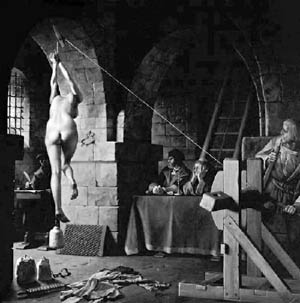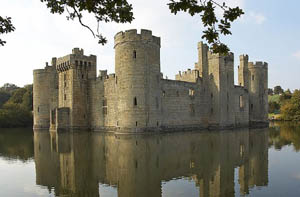Castle Architecture
|
|
|
|||||||||||
Prisons
Castles had always acted as prisons for noble captives. These were not prisons in the modern sense. Rather the prisoner was held under house arrest in a castle apartment. As Castles fell out of use after the medieval period some, like Lincoln Castle were put to use as real prisons for common criminals. A dungeon is a room or cell in which prisoners are held, especially underground. Dungeons are generally associated with medieval castles, though their association with torture probably belongs more to the Renaissance period and to Church torture chambers favoured by the Inquisition. An oubliette is a form of dungeon which was accessible only from a hatch in a high ceiling. The image of dark, damp dungeons as the scene of lengthy incarceration and unspeakable cruelty is a powerful one in popular culture. The word dungeon comes from Old French donjon (also spelt dongon), which in its earliest usage, meant "a keep, the main tower of a castle which formed the final defensive position to which the garrison could retreat when outer fortifications were overcome". The first recorded instance of the word in English near the beginning of the 14th century also meant "an underground prison cell beneath the castle keep". In English, the word dungeon now usually only signifies the sense of underground prison or oubliette, typically in a basement of a castle, while the alternate spelling donjon is generally reserved for the original meaning. In French the term donjon still refers to a "keep", and the term oubliette is a more appropriate translation of English "dungeon". An oubliette (from the French oubliette - literally "forgotten place") was a form of dungeon which was accessible only from a hatch in a high ceiling. The word comes from the same root as the French oublier, "to forget," as it was used for those prisoners the captors wished to forget. The earliest use of oubliette in French dates back to 1374, but its earliest adoption in English is Walter Scott's Ivanhoe in 1819. There is no reason to suspect that this particular place of incarceration was more than a flight of romantic elaboration on existing unpleasant places of confinement described during the Gothic Revival period. Few Norman keeps in English castles originally contained prisons, though they were more common in Scotland. Imprisonment was not a usual punishment in the Middle Ages, so most prisoners were kept pending trial or awaiting the penalty, or for political reasons. Purpose-built prison chambers in castles became more common after the twelfth century, when they were built into gatehouses or mural towers. Some castles had larger provision for prisoners, such as the prison tower at Caernarvon Castle. Alnwick Castle and Cockermouth Castle, both in Northumberland, had prisons in the gatehouse with oubliettes beneath them. Although many real dungeons are simply a single plain room with a heavy door or with access only from a hatchway or trapdoor in the floor of the room above, the use of dungeons for torture, along with their association to common human fears of being trapped underground, have made dungeons a powerful metaphor in a variety of contexts. Dungeons, in the plural, have come to be associated with underground complexes of cells and torture chambers. As a result, the number of true dungeons in castles is often exaggerated to interest tourists. Many chambers described as dungeons or oubliettes were in fact storerooms, water-cisterns or even latrines. |
|
||||||||||
|
|||||||||||
|
|
Learn More about Castle Architecture
 |
|
|||||||||
 |
|||||||||||
|
|
|||||||||||
|
|
|
|
|||||||||
|
|
|||||||||||
|
|
|||||||||
| :::: Link to us :::: Castle and Manor Houses Resources ::: © C&MH 2010-2014 ::: contact@castlesandmanorhouses.com ::: Advertising ::: |


